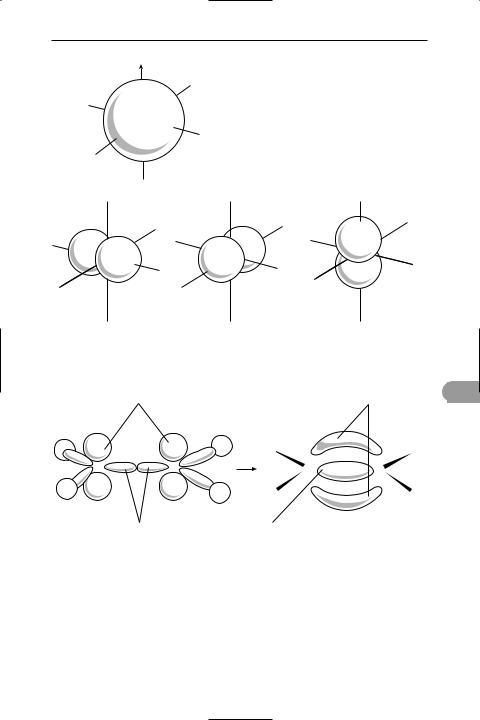
A Dictionary of Science
.pdf
oestrus |
576 |
have many cycles per year (i.e. they are polyoestrous) and the male may be sexually active all the time.
oestrus (heat) See oestrous cycle.
offset See runner.
offspring (progeny) New individual organisms that result from the process of sexual or asexual reproduction. See also f1; f2.
ohm Symbol Ω. The derived *SI unit of electrical resistance, being the resistance between two points on a conductor when a constant potential difference of one volt, applied between these points, produces a current of one ampere in the conductor. The former international ohm (sometimes called the ‘mercury ohm’) was deÜned in terms of the resistance of a column of mercury. The unit is named after Georg Ohm.
Ohm, Georg Simon (1787–1854) German physicist, who taught in Cologne, Berlin, Nuremberg, and Ünally (1849) Munich. He is best known for formulating *Ohm’s law in 1827. The unit of electrical resistance is named after him.
oohmmeter Any direct-reading instrument for measuring the value of a resistance in ohms. The instrument commonly used is a *multimeter capable of measuring also both currents and voltages. To measure resistance a dry cell and resistor are switched in series with the moving coil *galvanometer and the unknown resistance is connected across the instrument’s terminals. The value of the resistance is then read off an ohms scale. Such instruments are increasingly being replaced by electronic digital multimeters.
Ohm’s law The ratio of the potential
difference between the ends of a conductor to the current Ûowing through it is constant. This constant is the *resistance of the conductor, i.e. V = IR, where V is the potential difference in volts, I is the current in amperes, and R is the resistance in ohms. The law was discovered in 1827 by Georg Ohm. Most materials do not obey this simple linear law; those that do are said to be ohmic but remain so only if physical conditions, such as temperature,
remain constant. Metals are the most accurately ohmic conductors.
oil Any of various viscous liquids that are generally immiscible with water. Natural plant and animal oils are either volatile mixtures of terpenes and simple esters (e.g. *essential oils) or are *glycerides of fatty acids. Mineral oils are mixtures of hydrocarbons (e.g. *petroleum).
oil-immersion lens See immersion objective.
oil of vitriol See sulphuric acid.
oil of wintergreen Methyl salicylate (methyl 2-hydroxybenzoate, C8H8O3), a colourless aromatic liquid ester, b.p.
223°C. It occurs in the essential oils of some plants, and is manufactured from salicylic acid. It is easily absorbed through the skin and used in medicine for treating muscular and sciatic pain. Because of its attractive smell it is also used in perfumes and food Ûavourings.
oil sand (tar sand; bituminous sand) A sandstone or porous carbonate rock that is impregnated with hydrocarbons. The largest deposit of oil sand occurs in Alberta, Canada (the Athabasca tar sands); there are also deposits in the Orinoco Basin of Venezuela, Russia, USA, Madagascar, Albania, Trinidad, and Romania.
oil shale A Üne-grained carbonaceous sedimentary rock from which oil can be extracted. The rock contains organic matter – kerogen – which decomposes to yield oil when heated. Deposits of oil shale occur on every continent, the largest known reserves occurring in Colorado, Utah, and Wyoming in the USA. Commercial production of oil from oil shale is generally considered to be uneconomic unless the price of petroleum rises above the recovery costs for oil from oil shale. However, threats of declining conventional oil resources have resulted in considerable interest and developments in recovery techniques.
Oklo reactors Naturally occurring nuclear Üssion reactors that are believed to have existed in uranium deposits at Oklo in Gabon, West Africa, about 2000 million years ago. In 1972, French scientists noticed a slight difference in the normal

577 |
olivine |
235U/238U ratio in uranium ore from Oklo. Further detailed investigations showed that there had been 15 natural reactors in the ore deposits at Oklo, operating intermittently for about 1 million years. It is thought that the geology of the mine was an important factor in the creation of these reactors, in particular, the seepage of water through overlying rock, which functioned as a moderator. A similar natural reactor has been found at Bangombe, some miles south of Oklo, but no other comparable reactors have been found anywhere in the world. The Oklo reactors are of considerable interest. They involve basic nuclear processes occurring occurring 2000 million years ago and might give insights into the time dependence of *fundamental constants. More practically, Oklo can be regarded as a 2000-million- year experiment in the containment of nuclear waste. The reactors shut down naturally when the proportion of 235U decreased, and – for the same reason – natural reactors of this type could not occur today. The products of the reactor have, however, been localized because of the geology of the region, in particular, beds of granite underlying the ore deposits.
Olbers’ paradox If the universe is inÜnite, uniform, and unchanging the sky at night would be bright, as in whatever direction one looked one would eventually see a star. The number of stars would increase in proportion to the square of the distance from the earth; the intensity of light reaching the earth from a given star is inversely proportional to the square of the distance. Consequently, the whole sky should be about as bright as the sun. The paradox, that this is not the case, was stated by Heinrich Olbers (1758–1840) in 1826. (It had been discussed earlier, in 1744, by J. P. L. Chesaux.) The paradox is resolved by the fact that, according to the *big-bang theory, the universe is not inÜnite, not uniform, and not unchanging. For instance, light from the most distant galaxies displays an extreme *redshift and ceases to be visible.
oleate A salt or ester of *oleic acid.
oleÜnes See alkenes.
oleic acid An unsaturated *fatty acid
with one double bond, CH3(CH2)7CH: CH(CH2)7COOH; r.d. 0.9; m.p. 13°C. Oleic acid is one of the most abundant constituent fatty acids of animal and plant fats, occurring in butterfat, lard, tallow, groundnut oil, soya-bean oil, etc. Its systematic chemical name is cis-octadec-9- enoic acid.
oleum See disulphuric(vi) acid.
olfaction The sense of smell or the process of detecting smells. This is achieved by receptors in olfactory organs (such as the *nose) that are sensitive to airor water-borne chemicals. Stimulation of these receptors results in the transmission of information to the brain via the olfactory nerve.
Oligocene The third geological epoch of the *Tertiary period. It began about 38 million years ago, following the Eocene epoch, and extended for about 13.5 million years to the beginning of the Miocene epoch. The epoch was characterized by the continued rise of mammals; the Ürst pigs, rhinoceroses, and tapirs made their appearance.
Oligochaeta A class of hermaphrodite annelid worms that bear only a few bris-
tles (*chaetae). Oligochaetes are very o abundant in freshwater and terrestrial
habitats. The most familiar members of the class are the earthworm (Lumbricus) and the freshwater bloodworm (Tubifex).
oligopeptide See peptide.
oligosaccharide A carbohydrate (a type of *sugar) whose molecules contain a chain of up to 20 united monosaccharides. Oligosaccharides are formed as intermediates during the digestion of *polysaccharides, such as cellulose and starch.
oligotrophic Describing a body of water (e.g. a lake) with a poor supply of nutrients and a low rate of formation of organic matter by photosynthesis. Compare dystrophic; eutrophic.
olivine An important group of rockforming silicate minerals crystallizing in the orthorhombic system. Olivine conforms to the general formula (Mg,Fe)2SiO4 and comprises a complete series from pure magnesium silicate (forsterite, Mg2SiO4) to pure iron silicate (fayalite,

omasum |
578 |
Fe2SiO4). It is green, brown-green, or yel- low-green in colour.
omasum The third of four chambers that form the stomach of ruminants. See ruminantia.
omega-minus particle A spin 3/2
*baryon made up three strange quarks (see strangeness). The existence of the omega-minus particle, as well as its properties, were predicted by Murray GellMann in 1962 as part of a scheme to classify baryons, called the eightfold way. The omega-minus particle was subsequently discovered experimentally, thus demonstrating the validity of the eightfold way. This discovery was historically very important in the theoretical understanding of the *strong interactions. The mass of the omega mass particle is 1672.5 MeV and its average lifetime is 0.8 × 10–10 s. The omega minus particle has an electric charge of –1 (its *antiparticle has a charge of +1). See elementary particles.
ommatidium See compound eye.
omnivore An animal that eats both animal and vegetable matter. Pigs, for example, are omnivorous. Compare carnivore; herbivore.
ooncogene A dominant mutant allele of a cellular gene (a proto-oncogene) that disrupts cell growth and division and is capable of transforming a normal cell into a cancerous cell. Mutations in protooncogenes tend to relax mechanisms that control the cell cycle and accelerate cell division, leading to the cell proliferation that is characteristic of cancer. Some oncogenic mutations cause inhibition of programmed cell death (*apoptosis), so that cancerous cells are less likely to be destroyed by the body’s defences. Certain oncogenes of vertebrates are derived from viruses (see oncogenic).
oncogenic Describing a chemical, organism, or environmental factor that causes the development of cancer. Some viruses are oncogenic to vertebrates, notably the *retroviruses (including the Rous sarcoma virus of chickens), and some are suspected of being oncogenic (e.g. some of the *adenoviruses and *papovaviruses). Many of these viruses contain genes (known as *oncogenes) that
are responsible for the transformation of a normal host cell into a cancerous cell.
See also growth factor.
one gene–one polypeptide hypothesis The theory that each *gene is responsible for the synthesis of a single *polypeptide. It was originally stated as the one gene–one enzyme hypothesis by the US geneticist George Beadle (1903–89) in 1945 but later modiÜed when it was realized that genes also encoded nonenzyme proteins and individual polypeptide chains. It is now known that some genes code for various types of RNA involved in protein synthesis.
one-pot synthesis A method of synthesizing organic compounds in which the materials used are mixed together in a single vessel and allowed to react, rather than conducting the reaction in a sequence of separate stages.
onium ion An ion formed by adding a proton to a neutral molecule, e.g. the hydroxonium ion (H3O+) or the ammonium ion (NH4+).
ontogeny The developmental course of an organism from the fertilized egg through to maturity. It has been suggested that “ontogeny recapitulates *phylogeny”, i.e. the stages of development, especially of the embryo, reÛect the evolutionary history of the organism. This idea is now discredited.
oocyte See oogenesis.
oogamy Sexual reproduction involving the formation and subsequent fusion of a large, usually stationary, female gamete and a small motile male gamete. The female gamete may contain nourishment for the development of the embryo, which is often retained and protected by the parent organism.
oogenesis The production and growth of the ova (egg cells) in the animal ovary. Special cells (oogonia) within the ovary divide repeatedly by mitosis to produce large numbers of prospective egg cells (oocytes). When mature, these undergo meiosis, which halves the number of chromosomes. During the Ürst meiotic division a polar body and a secondary oocyte are produced. At the second mei-

579 |
operon |
otic division the secondary oocyte produces an ovum and a second polar body. Oocytes may be present in the ovaries at birth and may represent the total number of eggs to be produced.
oogonium 1. The female sex organ (*gametangium) of algae and fungi.
2. Any of the immature sex cells in the animal ovary that give rise to oocytes by mitotic divisions (see oogenesis).
Oort cloud A spherical region on the edge of the solar system thought to be the source of most long-period *comets. It is estimated to contain up to 1012 comets and to extend from 4500 billion to 15 000 billion kilometres from the sun. Disturbances caused by a passing star push the comets into solar orbits. It is named after Jan Oort (1899–1971).
oosphere (ovum; egg cell) The nonmotile female gamete in plants and some algae. In angiosperms (Ûowering plants) it is a cell in the *embryo sac of the ovule. In other plants it is situated in an *archegonium. In algae, such as Fucus, the oosphere is protected by an oogonium until it is shed into the water prior to fertilization. Many oospheres store food in the form of starch or oil droplets.
oospore A zygote that is produced as a result of *oogamy in certain algae and fungi. It contains food reserves, develops a protective outer covering, and enters a resting phase before germination. Compare zygospore.
opacity The extent to which a medium is opaque to electromagnetic radiation, especially to light. It is the reciprocal of the *transmittance. A medium that is opaque to X-rays and gamma rays is said to be radiopaque.
opal A hydrous amorphous form of silica. Many varieties of opal occur, some being prized as gemstones. Common opal is usually milk white but the presence of impurities may colour it yellow, green, or red. Precious opals, which are used as gemstones, display the property of opalescence – a characteristic internal play of colours resulting from the interference of light rays within the stone. Black opal has a black background against which the colours are displayed. The chief sources of
precious opals are Australia and Mexico. Geyserite is a variety deposited by geysers or hot springs. Another variety, diatomite, is made up of the skeletons of diatoms.
open chain See chain.
open cluster (galactic cluster) See star cluster.
open-hearth process A traditional but now obsolete method for manufacturing steel by heating together scrap, pig iron, etc., in a refractory-lined shallow open furnace heated by burning producer gas in air. It has been replaced by the *basicoxygen process.
open reading frame See reading frame.
opera glasses See binoculars.
operator A mathematical symbol indicating that a speciÜed operation should be carried out. For example, the operator √ in √x indicates that the square root of x should be taken; the operator d/dx in dy/dx indicates that y should be differentiated with respect to x, etc.
operculum 1. (in zoology) A lid or Ûap of skin covering an aperture, such as the gill slit cover of Üsh and larval amphibians
and the horny calcareous operculum se- o creted by many gastropod molluscs,
which closes the opening of the shell when the animal is inside. 2. (in botany) The cone-shaped lid of the *capsule of mosses, which is forcibly detached to release the spores.
operon A functionally integrated genetic unit for the control of gene expression in bacteria, as proposed in the *Jacob–Monod hypothesis. Typically it comprises a closely linked group of structural genes, coding for protein, and adjacent loci controlling their expression – an operator site and a promoter site. The structural genes tend to encode enzymes concerned with a particular biochemical pathway. *Transcription of the structural genes is prevented by binding of a repressor molecule to the operator site. Another molecule, the inducer, can bind to the repressor molecule, preventing it from binding to the operator and thus allowing the promoter site to bind the enzyme RNA polymerase, thereby initiating transcrip-

opiate |
580 |
tion. The repressor molecule is encoded by a regulator gene, which may be close to or distant from the operon. Some operons also have an attenuator region preceding the Ürst structural gene, where transcription may either stall or proceed according to the amount of end-product in the cell. See also lac operon.
opiate One of a group of drugs derived from opium, an extract of the poppy plant Papaver somniferum that depresses brain function (a narcotic action). Opiates include *morphine and its synthetic derivatives, such as *heroin and codeine. They are used in medicine chieÛy to relieve pain, but the use of morphine and heroin is strictly controlled since they can cause drug dependence and tolerance.
Oppenheimer–Volkoff limit The maximum mass a neutron star can have before it undergoes gravitational collapse to a *black hole. It is more difÜcult to estimate this limit than the analogous *Chandrasekhar limit for white dwarf stars. It is thought that the Oppenheimer–Volkoff limit is between two and three times the mass of the sun. It was Ürst calculated by Robert Oppenheimer and George Volkoff in 1939.
oopposition The moment at which a planet having its orbit outside that of the earth is in a line with the earth and the sun. When a planet is in opposition it can be observed during the night and is near to its closest point to the earth; it is therefore a favourable opportunity for observation.
opsin The lipoprotein component of
*rhodopsin, the light-sensitive pigment that occurs in the rod cells of the retina.
optical activity The ability of certain substances to rotate the plane of planepolarized light as it passes through a crystal, liquid, or solution. It occurs when the molecules of the substance are asymmetric, so that they can exist in two different structural forms each being a mirror image of the other (see chirality element). The two forms are optical isomers or enantiomers. The existence of such forms is also known as enantiomorphism (the mirror images being enantiomorphs). One form will rotate the light in one direction and the other will rotate it by an equal amount in the other. The two possible forms are described as *dextrorotatory or *laevorotatory according to the direction of rotation. An
equimolar mixture of the two forms is not optically active. It is called a racemic mixture (or racemate). PreÜxes are used to designate the isomer: (+)- (dextrorotatory),
(–)- (laevorotatory), and (±)- (racemic mixture) are now preferred to, and increasingly used for, the former d-, l-, and dl-, respectively. In addition, certain molecules can have a meso-isomer in which one part of the molecule is a mirror image of the other. Such molecules are not optically active.
Molecules that show optical activity have no plane of symmetry. The commonest case of this is in organic compounds in which a carbon atom is linked to four different groups. An atom of this type is said to be a chiral centre. Asymmetric molecules showing optical activity can also
|
H |
|
|
H |
|
|
OH |
HOOC |
OH |
OH |
|
COOH |
H |
|
COOH |
|
C |
|
C |
|
C |
||
|
|
|
|
|
|
|
|
|
C |
|
C |
|
C |
||
HOOC |
H |
H |
|
COOH |
H |
|
COOH |
|
OH |
|
|
OH |
|
|
OH |
|
D-form |
|
L-form |
|
meso-form |
||
Optical activity. Isomers of tartaric acid.

581 |
optical telescope |
occur in inorganic compounds. For example, an octahedral complex in which the central ion coordinates to six different ligands would be optically active. Many naturally occurring compounds show optical isomerism and usually only one isomer occurs naturally. For instance, glucose is found in the dextrorotatory form. The other isomer, (–)- or l-glucose, can be synthesized in the laboratory, but cannot be synthesized by living organisms. See also absolute configuration.
optical axis (principal axis; optic axis)
The line passing through the *optical centre and the centre of a curvature of a *lens or spherical *mirror.
optical brightener See brighteners.
optical centre The point at the geometrical centre of a *lens through which a ray of light entering the lens passes without deviation.
optical Übre A *wave guide through which light can be transmitted with very little leakage through the sidewalls. In the step-index Übre a pure glass core, with a diameter between 6 and 250 micrometres, is surrounded by a coaxial glass or plastic cladding of lower refractive index. The cladding is usually between 10 and 150 micrometres thick. The interface between core and cladding acts as a cylindrical mirror at which *total internal reÛection of the transmitted light takes place. This structure enables a beam of light to travel through many kilometres of Übre. In the graded-index Übre, each layer of glass, from the Übre axis to its outer wall, has a slightly lower refractive index than the layer inside it. This arrangement also prevents light from escaping through the Übre walls by a combination of refraction and total internal reÛection, and can be made to give the same transit time for rays at different angles.
Fibre-optic systems use optical Übres to transmit information, in the form of coded pulses or fragmented images (using bundles of Übres), from a source to a receiver. They are also used in medical instruments (Übrescopes) to examine internal body cavities, such as the stomach and bladder.
optical Ûat A Ûat glass disc having very
accurately polished surfaces so that the deviation from perfect Ûatness does not exceed (usually) 50 nanometres. It is used to test the Ûatness of such plane surfaces as gauge anvils by means of the *interference patterns formed when parallel beams of light pass through the Ûat and are reÛected by the surface being inspected.
Surfaces are said to be optically Ûat if the deviation from perfect Ûatness is smaller than the wavelength of light.
optical glass Glass used in the manufacture of lenses, prisms, and other optical parts. It must be homogeneous and free from bubbles and strain. Optical crown glass may contain potassium or barium in place of the sodium of ordinary crown glass and has a refractive index in the range 1.51 to 1.54. Flint glass contains lead oxide and has a refractive index between 1.58 and 1.72. Higher refractive indexes are obtained by adding lanthanoid oxides to glasses; these are now known as lanthanum crowns and Ûints.
optical isomers See optical activity.
optical lever An experimental device used to measure angular rotation (e.g. in a
*galvanometer or *torsion balance). Typi- o cally, a small mirror is attached to the ro-
tating object, and a beam of light is directed onto the mirror and reÛected onto a scale. The angle turned through by the beam is twice the angle turned through by the mirror.
optical microscope See microscope.
optical molasses See laser cooling.
optical pumping See laser.
optical pyrometer See pyrometry.
optical rotary dispersion (ORD) The effect in which the amount of rotation of plane-polarized light by an optically active compound depends on the wavelength. A graph of rotation against wavelength has a characteristic shape showing peaks or troughs.
optical rotation Rotation of planepolarized light. See optical activity.
optical telescope See telescope.

optical temperature |
582 |
optical temperature See radiation temperature.
optic axis 1. The direction in a doubly refracting crystal in which light is transmitted without double refraction. 2. See optical axis.
optic lobes See midbrain.
optic nerve The second *cranial nerve: a paired sensory nerve that runs from each eye to the brain. It is responsible for conveying visual stimuli received by the rods and cones in the retina to the brain for interpretation.
optics The study of *light and the phenomena associated with its generation, transmission, and detection. In a broader sense, optics includes all the phenomena associated with infrared and ultraviolet radiation. Geometrical optics assumes that light travels in straight lines and is concerned with the laws controlling the reÛection and refraction of rays of light. Physical optics deals with phenomena that depend on the wave nature of light, e.g. diffraction, interference, and polarization.
oral cavity See buccal cavity.
oral contraceptive Any hormonal
opreparation taken in the form of a pill to prevent conception (see birth control). The most common form is the combined pill, which contains an *oestrogen and a *progestogen. Both act to suppress ovulation, while the progestogen additionally causes changes in the viscosity of cervical mucus and alters the lining of the womb, both of which decrease the chances of fertilization should ovulation occur. The so-called ‘minipill’ contains only a progestogen and has fewer side effects than the combined pill. Emergency contraception (the so-called ‘morning-after pill’), to prevent pregnancy after unprotected sexual intercourse, consists of two spaced doses of either a combined oestrogen–
progestogen preparation or an oestrogen alone, the Ürst dose being taken within 72 hours of intercourse.
orbit 1. (in astronomy) The path through space of one celestial body about another.
For one small body moving in the gravitational Üeld of another the orbit is a *conic section. Most such orbits are elliptical and
most planetary orbits in the solar system are nearly circular. The shape and size of an elliptical orbit is speciÜed by its eccentricity, e, and the length of its semimajor axis, a. 2. (in physics) The path of an electron as it travels round the nucleus of an atom. See orbital. 3. (in anatomy) Either of the two sockets in the skull of vertebrates that house the eyeballs.
orbital A region in which an electron may be found in an atom or molecule. In the original *Bohr theory of the atom the electrons were assumed to move around the nucleus in circular orbits, but further advances in quantum mechanics led to the view that it is not possible to give a deÜnite path for an electron. According to *wave mechanics, the electron has a certain probability of being in a given element of space. Thus for a hydrogen atom the electron can be anywhere from close to the nucleus to out in space but the maximum probability in spherical shells of equal thickness occurs in a spherical shell around the nucleus with a radius equal to the Bohr radius of the atom. The probabilities of Ünding an electron in different regions can be obtained by solving the Schrödinger wave equation to give the wave function ψ, and the probability of location per unit volume is then proportional to |ψ|2. Thus the idea of electrons in Üxed orbits has been replaced by that of a probability distribution around the nucleus – an atomic orbital (see illustration). Alternatively, the orbital can be thought of as an electric charge distribution (averaged over time). In representing orbitals it is convenient to take a surface enclosing the space in which the electron is likely to be found with a high probability.
The possible atomic orbitals correspond to subshells of the atom. Thus there is one s-orbital for each shell (orbital quantum number l = 0). This is spherical. There are three p-orbitals (corresponding to the three values of l) and Üve d-orbitals. The shapes of orbitals depend on the value of l. For instance, p-orbitals each have two lobes; most d-orbitals have four lobes.
In molecules, the valence electrons move under the inÛuence of two nuclei (in a bond involving two atoms) and there are corresponding molecular orbitals for electrons (see illustration). It is convenient

583 |
orbital |
z
symmetrical s-orbital
 x
x
y 
z |
z |
z |
x |
|
x |
x |
|
|
||
y |
y |
|
y |
|
|
||
px |
py |
|
pz |
H
H
Orbitals
three equivalent p-orbitals, each having 2 lobes atomic orbitals
|
p-orbitals |
|
|
pi orbital |
o |
|
|
H |
H |
|
H |
|
|
|
|
||
C |
C |
|
C |
C |
|
|
|
|
|
||
|
|
H |
H |
|
H |
|
|
|
|
|
|
|
hybrid sp3-orbitals |
|
sigma orbital |
|
|
|
molecular orbitals: formation of the double bond in ethene |
|
|
||
in considering these to regard them as formed by overlap of atomic orbitals. In a hydrogen molecule the s-orbitals on the two atoms overlap and form a molecular orbital between the two nuclei. This is an example of a sigma orbital. In a double bond, as in ethene, one bond is produced by overlap along the line of axes to form a
sigma orbital. The other is produced by sideways overlap of the lobes of the p- orbitals (see illustration). The resulting molecular orbital has two parts, one on each side of the sigma orbital – this is a pi orbital. It is also possible for a delta orbital to form by lateral overlap of two d- orbitals. In fact, the combination of two

orbital quantum number |
584 |
atomic orbitals produces two molecular orbitals with different energies. The one of lower energy is the bonding orbital, holding the atoms together; the other is the antibonding orbital, which would tend to push the atoms apart. In the case of valence electrons, only the lower (bonding) orbital is Ülled.
In considering the formation of molecular orbitals it is often useful to think in terms of hybrid atomic orbitals. For instance, carbon has in its outer shell one s- orbital and three p-orbitals. In forming methane (or other tetrahedral molecules) these can be regarded as combining to give four equivalent sp3 hybrid orbitals, each with a lobe directed to a corner of a tetrahedron. It is these that overlap with the s-orbitals on the hydrogen atoms. In ethene, two p-orbitals combine with the s- orbital to give three sp2 hybrids with lobes in a plane pointing to the corners of an equilateral triangle. These form the sigma orbitals in the C–H and C–C bonds. The remaining p-orbitals (one on each carbon) form the pi orbital. In ethyne, sp2 hybridization occurs to give two hybrid orbitals on each atom with lobes pointing along the axis. The two remaining p-
oorbitals on each carbon form two pi orbitals. Hybrid atomic orbitals can also involve d-orbitals. For instance, squareplanar complexes use sp2d hybrids; octahedral complexes use sp3d2.
orbital quantum number See atom.
orbital velocity (orbital speed) The speed of a satellite, spacecraft, or other body travelling in an *orbit around the earth or around some other celestial body. If the orbit is elliptical, the orbital speed, v, is given by:
v = √[gR2(2/r – 1/a)],
where g is the accceleration of free fall, R is the radius of the orbited body, a is the semimajor axis of the orbit, and r is the distance between the orbiting body and the centre of mass of the system. If the orbit is circular, r = a and v = √(gR2/r).
OR circuit See logic circuits.
order 1. (in chemistry) In the expression for the rate of a chemical reaction, the sum of the powers of the concentrations
is the overall order of the reaction. For instance, in a reaction
A + B → C
the rate equation may have the form
R = k[A][B]2
This reaction would be described as Ürst order in A and second order in B. The overall order is three. The order of a reaction depends on the mechanism and it is possible for the rate to be independent of concentration (zero order) or for the order to be a fraction. See also molecularity; pseudo order.
2.(in mathematics) The number of times
a variable is differentiated. dy/dx represents a Ürst-order derivative, d2y/dx2 a sec- ond-order derivative, etc. In a *differential equation the order of the highest derivative is the order of the equation. d2y/dx2 +
2dy/dx = 0 is a second-order equation of the Ürst degree. See also degree.
3.(in taxonomy) A category used in the
*classiÜcation of organisms that consists of one or several similar or closely related families. Similar orders form a class. Order names typically end in -ales in botany, e.g. Rosales (roses and orchard fruits), and in -a in zoology, e.g. Carnivora (Ûesh eaters).
4. (in physics) A category of *phase transition.
order of magnitude A value expressed to the nearest power of ten.
order parameter A quantity that characterizes the order of a phase of a system below its *transition temperature. An order parameter has a non-zero value below the transition temperature and a zero value above the transition temperature. An example of an order parameter is magnetization (see magnetism) in a ferromagnetic system. If the phase transition is continuous (i.e. there is no *latent heat), the order parameter goes to zero continuously as the transition temperature is approached from below. Disorder parameters are quantities that are non-zero above the transition temperature and zero beneath it. Order parameters are associated with the *broken symmetry of a system.
ordinary ray See double refraction.

585 |
organometallic compound |
ordinate See cartesian coordinates.
Ordovician The second geological period of the Palaeozoic era, following the Cambrian and preceding the Silurian periods. It began about 505 million years ago and lasted for about 67 million years. The period was named by the British geologist Charles Lapworth (1842–1920) in 1879. *Graptolites, in deep-water deposits, are the dominant fossils. Other fossils include *trilobites, brachiopods, bryozoans, gastropods, bivalves, echinoids, crinoids, nautiloid cephalopods, and the Ürst corals.
ore A naturally occurring mineral from which a metal and certain other elements (e.g. phosphorus) can be extracted, usually on a commercial basis. Metals may be present in ores in the native form, but more commonly they occur combined as oxides, sulphides, sulphates, silicates, etc.
ore dressing See beneficiation.
oregonator A type of chemical reaction mechanism that causes an *oscillating reaction. It is the type of mechanism responsible for the *B–Z reaction, and involves Üve steps of the form:
A + Y → X
X + Y → C
A + X → 2X + Z
2X → D
Z → Y
Autocatalysis occurs as in the *Lotka– Volterra mechanism and the *brusselator. The mechanism was named after Oregon in America, where the research group that discovered it is based.
organ Any distinct part of an organism that is specialized to perform one or a number of functions. Examples are ears, eyes, lungs, and kidneys (in animals) and leaves, roots, and Ûowers (in plants). A given organ will contain many different *tissues.
organ culture The culture of complete living organs (explants) of animals and plants outside the body in a suitable culture medium. Animal organs must be small enough to allow the nutrients in the culture medium to penetrate all the cells. Whole plant roots and even root systems
can be kept alive in such conditions for a considerable period of time. See also explantation.
organelle A minute structure within a eukaryotic *cell that has a particular function. Examples of organelles are the nucleus, mitochondria, and lysosomes.
organic chemistry The branch of chemistry concerned with compounds of carbon.
organic evolution The process by which changes in the genetic composition of populations of organisms occur in response to environmental changes. See adaptation; evolution. Compare biochemical evolution.
organism An individual living system, such as an animal, plant, or *microorganism, that is capable of reproduction, growth, and maintenance.
organizer An area of an animal embryo that causes adjacent areas of the embryo to develop in a certain way. The primary organizer (blastopore lip or archenteron roof) causes the *gastrula to develop as a complete organism.
organo- PreÜx used before the name of
|
|
|
an element to indicate compounds of the |
o |
|
|
|
|
elements containing organic groups (with |
|
|
the element bound to carbon atoms). For |
|
|
example, lead(IV) tetraethyl is an organo- |
|
|
lead compound. |
|
|
organogenesis The formation of or- |
|
|
gans during embryonic development. In |
|
|
animals this begins following the re- |
|
|
arrangement of the cells at gastrulation, |
|
|
when the three germ layers are fully |
|
|
formed in their correct positions. Dividing |
|
|
cells of the *gastrula begin to differenti- |
|
|
ate and the rudimentary organs and organ |
|
|
systems begin to form. See differentia- |
|
|
tion; ectoderm; endoderm; mesoderm. |
|
|
organometallic compound A com- |
|
|
pound in which a metal atom or ion is |
|
|
bound to an organic group. Organometal- |
|
|
lic compounds may have single metal– |
|
|
carbon bonds, as in the aluminium alkyls |
|
|
(e.g. Al(CH3)3). In some cases, the bonding |
|
|
is to the pi electrons of a double bond, as |
|
|
in complexes formed between platinum |
|
|
and ethene, or to the pi electrons of a |
|
|
ring, as in *ferrocene. |
|
|
